Tesla has ramped up warnings to customers that a significant policy shift is just weeks away. The current $7,500 federal tax credit for new electric vehicles, and $4,000 for eligible used EVs, will be eliminated after September 30. As a result, both consumer demand and automaker strategies are under scrutiny. Tesla’s actions reflect broader uncertainty in the electric vehicle sector as federal incentives near their expiration, resulting in potential changes to market dynamics and consumer affordability.
A review of earlier reports showed ongoing speculation about the longevity of the EV tax credit, but the timeline has now crystallized. Analysts flagged the possibility of withdrawal as early as the Trump Administration, but official confirmation intensified automaker messaging. Industry competitors previously counted on these credits as a cornerstone of their value proposition, often designing sales events and promotions around tax relief windows. Tesla’s proactive approach stands out compared to less visible campaigns from rivals.
Timeline for Tax Credit Expiry
Consumers must both order and take delivery of eligible Teslas by September 30 to qualify for the federal credit. Orders alone will not suffice if delivery occurs after the deadline, making timing critical for buyers. The current stimulus reduces the entry-level Tesla Model 3 Rear-Wheel-Drive price from $42,490 to $34,990, creating considerable savings and lowering monthly payments.
Implications for Tesla’s Market Position
Tesla leadership, including CEO Elon Musk, has publicly dismissed concerns about ending the subsidy. In a direct statement, Musk said,
“Take away the subsidies. It will only help Tesla.”
Despite the approaching deadline, he maintains that the absence of these incentives may actually work in Tesla’s favor as their production efficiencies improve and new affordable models launch soon.
How Will the Industry Respond?
Tesla asserts that it is better positioned to weather the subsidy removal than competitors. Musk reinforced this sentiment, stating,
“In my view, we should end all government subsidies, including those for EVs, oil and gas.”
Market observers are watching whether Tesla’s rivals can maintain volume and pricing without federal support, especially as Tesla hints at a broader rollout of cost-effective electric vehicles later in the year.
The federal EV tax credit served as a notable lever for accelerating consumer adoption of electric vehicles by reducing upfront costs. Its expiration sets the stage for a test of both market resilience and consumer demand at higher price points. As Tesla prepares to launch more accessible models and underscores its focus on operational efficiency, the impact of expiring incentives will become clearer. Buyers interested in brands such as Model 3 and similar offerings from other companies should pay close attention to delivery timelines. Automakers and consumers alike are entering a period of adaptation, where market strategies will shift based on new realities. Potential buyers can benefit by acting promptly to leverage existing tax incentives before they expire.
- Federal EV tax credits end September 30, impacting Tesla buyers’ savings.
- Tesla urges orders and delivery before deadline to secure incentives.
- Loss of subsidy may alter electric vehicle market dynamics significantly.










